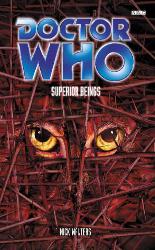The Discontinuity Guide
The Past Doctor Adventures
Superior Beings
June 2001

(Features the Fifth Doctor and Peri between Planet of Fire and The Caves of Androzani)
Author: Nick Walters
Editor: Justin Richards
Roots: The Day of the Triffids (The Gardeners). The TARDIS provides Peri with a copy of The Catcher In the Rye. I want something's flesh is a Withnail & I quote. Peri has read a short story by Edgar Allen Poe.
Continuity: The Valetheske are vicious carnivores that hail from the planet Valeth Skettra, who live only to hunt and reproduce. They will resort to cannibalism, often as a means of execution. Thousands of years ago, they had a galactic empire, until the Khorlthochloi decided that were becoming too aggressive and created a plague specific to the Valetheske, wiping most of them out. The survivors rebuilt their culture, and several set out on the Great Mission, a centuries long-quest to find and destroy the Khorlthochloi, whom they had worshipped as Gods. They have spacecraft, but have not invented the faster-than-light drive they travel for hundreds of years in cryogenic suspension, using nanites to aid in their awakening, which they refer to as the long sleep. They keep live prey, usually humans, similarly frozen during this time, to provide them with food on waking. They worship a female hero named Azreske and must undergo a ceremony called the Ten Trials of Azreske in order to become hunters when they come of age, and believe that they go to the Hall of the Dead after death. Most Valetheske are unable to resist the lure of live prey and cannot control their bloodlust. They are stronger than most humans. The Valetheske farm cattle animals for prey on Valeth Skettra, and can synthesise artificial flesh for emergencies. Their ships are equipped with numerous weapons, including A-, Q-, and Z-bombs, and Scourblaze missiles.
The Khorlthochloi were an ancient and powerful race that guided the development of lesser races thousands of years ago, described as mountain-sized ebony giants with eyes of fire. The Doctor has heard of them, also by the name Korlevalulaw and other names. They were extremely long-lived and eventually began to evolve beyond the physical plane, becoming creatures of pure thought. They elected to keep their physical bodies alive in case they needed to return to them, and created the Garden planet with an automated system for keeping their bodies nurtured. They encountered an unspecified threat in the dimension of pure thought and attempted to return to their bodies, but their bodies autonomic systems had developed to such an extent that their minds were rejected and were destroyed by the threat. Over the millennia, their bodies devolved, becoming smaller, cow-sized mindless insects.
The Eknuri are highly advanced humans from the colony Eknur 4, who used genetics to alter themselves into physically perfect beings. They can live for up to two hundred years. They have mastered all of the arts and sciences, and practice sex for pleasure. Eknur 4 is described by the Doctor as one of the [700] Wonders of the Universe. They use warpfield technology to travel instantly between planets, can manipulate the weather and terraform planetoids with ease, and play an instrument called a viheula. They can travel locally using skyboats. Eknur 4 has many visitors from Earth. The Eknuri starto-surf on Voriakaan.
The Gardeners and Harvesters are autotrophic, motile plants, controlled by the plasma strand. In response to hostile aliens, they are physically transformed into lethal poison spine-covered killers. Despite being autotrophic, they are so complex that they require mineral supplementation from the ground. There is another planet in the same system as the garden, but it is a lifeless rock.
The Doctor's celery is not visibly physically attached to his lapel. He once told Peri that he never gets on with soldiers [presumably the Brigadier is an exception!]. He cryptically remarks that he is either from the far future or the distant past.
The TARDIS provides Peri with various gifts, and frequently reorganizes its layout. It contains a potting shed occupied by a solitary garden gnome, and a room full of bicycles. It also has an actual bathroom, as opposed to the swimming pool. The temporal grace circuits are once again broken, to the Doctor's surprise [suggesting that he has attempted to repair them since Earthshock]. It carries oxygen masks and a coffin.
Peri is 19. She doesn't believe in Heaven or Hell. She visited the Boston Botanical Centre with her mother when she was eleven, and also visited Bath Abbey as a child.
Aline knows of two or three species that can time travel, including the Time Lords. She had latent psychic abilities, which were awoken by her Encounter. No human has ever published a xenology paper on the Time Lords.
Sontaran flesh is notoriously tough, tasteless and carcinogenic. Following a skirmish with them, a group of Valetheske were forced to live off dead Sontarans for three lunar cycles, causing Ruvis to develop cancer.
Links: The Valetheske were first mentioned in Dry Pilgrimage. The Doctor bemoans the loss of his sonic screwdriver (The Visitation). The Hamilton Smith institute is mentioned, which is probably named after Professor Hamilton Smith from Dry Pilgrimage.
Location: The Eknuri planetoid, c2994; the Valetheske ship and the Garden, c3094.
Future History: By 2594 the oppressive Earth Empire has colonized the Thynemnus system, and established a military outpost on Korsair to protect it. The indigents objected to the invasion, and frequently attacked the colonists. When the Valetheske arrived they took all of the colonists and indigents as prey.
Unrecorded Adventures: The Doctor has a jacket belonging to Amelia Earhart.
The Bottom Line: Excellent characterisation of the Valetheske stops this from being Invasion of the Fox-People, but a mediocre plot and uniformly forgettable supporting characters, particularly the Eknuri, hamstring the whole thing. The Doctor comes across as weak and indecisive and the whinging Peri is more suited to her characterisation during the Sixth Doctor's era.
Discontinuity Guide by Paul Clarke
| 
